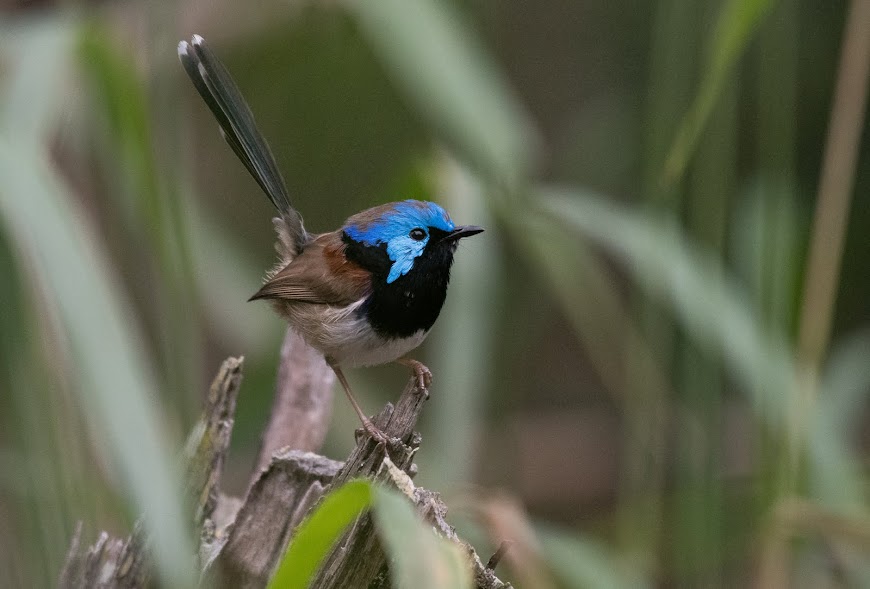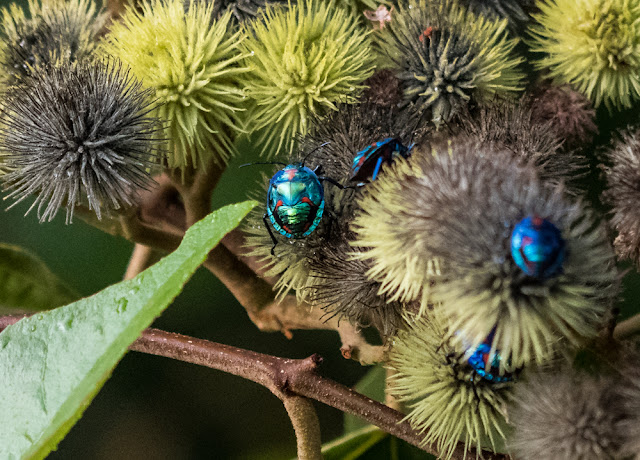EARLY APRIL
The Southern Boobook is Australia's most common Owl, it is not easily found during the day as it likes to roost sheltered in thick foliage or in a hollow, this one was harassed by many birds including Noisy Miners, Gray Butcherbirds, Pied Currawongs and Blue-faced Honeyeaters, if it were not for them making so much noise, I would have never known the owl was there. The noise and attacks toward the owl went on for a while, then at some point all the birds lost interest and left.
The Southern Boobook is Australia's most common Owl, it is not easily found during the day as it likes to roost sheltered in thick foliage or in a hollow, this one was harassed by many birds including Noisy Miners, Gray Butcherbirds, Pied Currawongs and Blue-faced Honeyeaters, if it were not for them making so much noise, I would have never known the owl was there. The noise and attacks toward the owl went on for a while, then at some point all the birds lost interest and left.
The Varied Triller (an immature male above) hasn't been recorded at Banks Street reserve for a long time.
A male Golden Whistler above.
A male Rufous Whistler below.
A male Rufous Whistler below.
The Shining Bronze-Cuckoos of the lucidus subspecies (above) have turned up in the Reserve, distinguished from the plagosus Shining Bronze-cuckoo (photos from last month) mostly by the green shine on the head, they come from New Zealand, where they breed, and are now on their way to the Solomon Islands and New Britain to spend the winter. After their migration they certainly were very hungry as they could not stop eating caterpillars.
Torresian Crows are gathering in larger numbers, on 9.4 I estimated about 30, all crowing, flying around and perching on top the highest Eucalyptus trees as if they could not find any peace. Thirty is a large number for Banks Street Reserve as usually I see about five or six.
I had never seen a Welcome Swallow, chasing or following the Brown Goshawk before, the Goshawk didn't mind nor did it go after the Swallow. One of the young birds born last spring is still hanging around its parents territory, I saw all three birds circling above the Reserve on 10.4.19.
Immature Brown Goshawk

The Black-faced Monarchs are still migrating through Banks Street Reserve, above an immature.

Pheasant Coucal in non-breeding plumage.
A very young Royal Spoonbill at dawn.
Many Eucalyptus trees are flowering and this is attracting many insects as well as birds. A female Leaden Flycatcher above and a juvenile White-throated Gerygone below.
Laughing Kookaburra
Blue-faced Honeyeater
Olive-backed Oriole
Galah
A pair of Masked Lapwings chased away the bird with a deformed bill (below on the right), was it a territorial dispute? Soon after, the pair looked rather triumphant, march-walking and calling together showing their yellow spurs on the wings.
After not hearing the Pied Butcherbirds singing much through the summer, it's very nice to have them back (not that they went anywhere I don't think) with their beautiful calls. They seem to be more social now as they sometimes gather in small, rather vocal groups.
The bee hive in the tree hollow is getting larger although the number of bees seems to be decreasing, are they retreating further in the hollow or are they going somewhere else?
With cooler temperatures and after the rains of last month, Banks Street Reserve is showing an array of colourful berries, flowers, mushrooms and mosses. The following selection shows what you can see here in early April, I have to thank the Facebook page Plant Identification Australia who helped me identifying all of the plants since my knowledge is very limited.
Russula persanguinea
Foambark - Jagera pseudorhus, a rainforest tree, its early-stage fruits have a wine-red colour, as the fruits mature they become orange-brown with irritating hair.
Chainfruit - Alyxia ruscifolia
Banana Bush - Tabernaemontana pandacaqui
Mickey Mouse Plant - Ochna serrulata, an introduced and invasive weed.

Above, a Diamond-leaf Pittosporum - Auranticarpa rhombifolia, a native rainforest tree.
Moss
MID APRIL
The New Zealand Shining Bronze-Cuckoos (subspecies lucidus) seen in early April are still in the Reserve, in the same caterpillar-laden tree of a few days ago, they were both feeding and one was preening too. The tree has almost all the leaves eaten by the caterpillars.
Australian Wood Ducks also called Maned Ducks seem to be back as regulars after the weather has cooled down.
The Brush Turkeys have completed their moult and their plumage looks very good for the winter, they are keeping a low profile, they are quiet, they hide away more promptly and their numbers have dropped.
This Straw-necked Ibis was just in the right spot so that the sun hit its feathers at the right angle to reveal the most colourful iridescence.
This young Australian Magpie is still following its parents around, it has been a few months now.
A Silver-eye checking out a Mickey Mouse Bush flower.
Below, a Long-pod Wattle or Flat-stemmed Wattle - Acacia complanata
Above, a Black Wattle - Acacia concurrens
Climbing Nightshade - Solanum seaforthianum, an exotic and invasive vine from South America.
The Great Egret is visiting less frequently now, it started feeding with the Royal Spoonbill soon after I took this photo.
An immature Fan-tailed Cuckoo above.
Little black Cormorant.
The first Rose Robin, a female above, arrived on 17.4.19
These two Spangled Drongos were calling to each other with their head-tufts erected, could they be reinforcing their bond already before the next breeding season?
A male Magpie-lark above.
A rare visitor for Banks Street Reserve, the Australasian Darter, an adult male.
Juvenile Rufous Fantail above.
Scurvy Weed - Commelina cyanea, a native perennial herb.
Lichen
Stink bugs on a Banana Bush.
LATE APRIL
Common Ringtail Possum
Spangled Drongo
Exciting to see a Whistling Kite for the first time here, it flew over the west bridge heading north-west.
Nymph-stage Cotton Harlequin bugs (Tectocoris diophthalmus) feeding (?) on Brown Kurrajong - Commersonia bartramia.
Prickly Daviesia (or Bitter Pea) - Daviesia villifera
Spangled Drongos calling to each other.
Figbird feeding on the fruits of a White Cedar (Melia azedarach).
What a surprise to see the Rufous-tailed Bush-hen one morning early, they had disappeared for a few weeks, obviously they are still around but keeping very quiet and hidden among the vegetation, coming out only occasionally.
The fruits of the Foambark (Jagera pseudorhus) have turned dull and brown, see earlier in this post what they looked like at the beginning of April.
While the fruits of the Foambark are turning dull, males Variegated Fairy Wrens may be turning back to their bright colours after only a few weeks of dullness, this male above briefly came out of the long grass in the morning darkness.
Pastel Flower - Psuderanthemum variabile
 |
| Star Goodenia - Goodenia rotundifolia - found on the dry side of the forest. |
Black Wattles are in full bloom and they smell amazing.
Royal Spoonbill and Great Egret fishing together between light and shadows, along Breakfast Creek.
A Pacific Black Duck preening.
A male Spotted Pardalote above, a winter visitor for the Reserve.
It was quite surprising to see a Brown Gerygone (on 28.4.19), a first time here for me, not reported since 2011. Brown Greygones are usually found in rain forest habitat at higher altitude. Bird books list them as sedentary, but they can visit drier woodlands at lower altitude in winter.
This April I have visited the Reserve 13 times, I saw and heard a total of 70 species of birds, an average of 41 species per outing. This link has a complete list of all the birds recorded this month at Banks Street Reserve.











































































